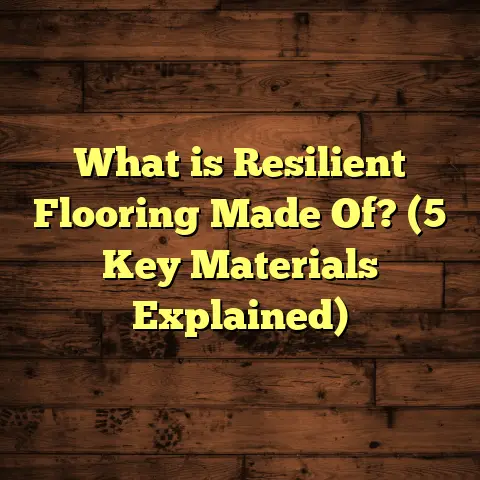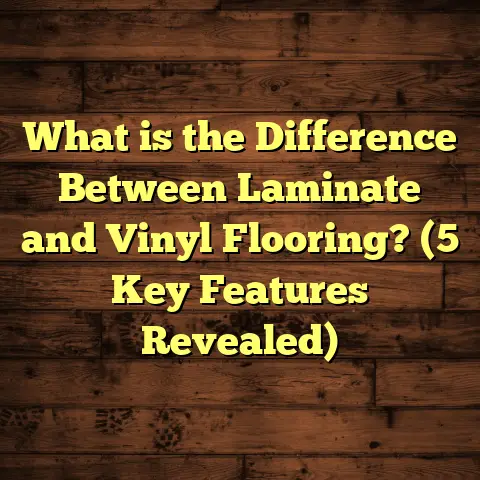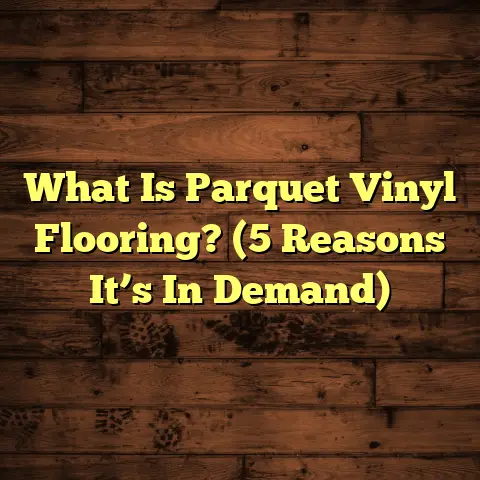What is a Floor Polisher? (5 Essential Tips for a Shine)
Imagine you’ve just installed a brand-new hardwood floor in your home.
It gleams under the sunlight, and you’re thrilled with how it transforms the room.
But after a few months, that shine starts to fade.
You try cleaning it, but it just doesn’t bring back the luster you loved.
That’s when you might start wondering: what’s the secret to keeping floors shining like new?
For me, the answer has always been a floor polisher.
What Is a Floor Polisher?
A floor polisher is a machine designed to clean, buff, and restore the shine of floors.
At its core, it works by spinning a brush or pad at high speeds to polish the surface.
This action smooths out minor scratches, removes scuff marks, and evenly applies polish or wax,
resulting in a glossy, well-maintained floor that looks almost brand new.
Floor polishers come in many shapes and sizes:
- Small handheld models for quick touch-ups
- Medium-sized machines for residential use
- Large commercial-grade polishers for offices or public spaces
Each type has its own strengths and ideal uses depending on the flooring material and the area size.
How Does It Work?
The technology behind floor polishers is pretty straightforward but effective.
They rotate either in one direction (rotary) or follow a random orbital motion to buff floors.
The spinning action agitates the floor surface to:
- Remove dirt and grime embedded in scratches
- Smooth out imperfections
- Evenly spread polish or wax coatings
You can think of it like buffing a car’s paint to bring back its shine.
Different Polishing Pads and Brushes
One of the key factors that influence performance is the type of pad or brush used with the polisher:
- Wool pads: Soft and gentle, great for polishing hardwood without damage
- Nylon brushes: Medium stiffness for scrubbing tile or stone surfaces
- Abrasive pads: Tougher pads used to remove stubborn stains or old polish layers
Choosing the right pad is critical to avoid damaging your floors while achieving the best shine.
My First Experience With a Floor Polisher
I’ll never forget the first time I used a floor polisher at home.
I had just installed oak hardwood floors in my living room and wanted to keep them looking fresh.
Initially, I tried regular mopping and cleaning, but the shine quickly dulled under daily wear.
A friend recommended renting a rotary buffer from a local store.
I was nervous because I’d heard they could damage floors if not used correctly.
But after reading instructions carefully, I gave it a try on a small patch first.
The results blew me away — the floor looked brighter, smoother, and cleaner instantly.
That little experiment convinced me that floor polishers were worth investing in for any serious flooring care.
Comparing Floor Polisher Types: What Worked for Me?
Over several years, I experimented with different types of floor polishers on various floors — hardwood, vinyl, tile.
Here’s what I found about each type based on hands-on experience:
Rotary Buffers
These machines spin in one direction at high speed using large circular pads.
Best for: Hard surfaces like tile or stone floors that can withstand aggressive polishing.
Pros:
- Powerful cleaning action
- Removes deep stains and old wax buildup effectively
Cons:
- Heavy and difficult for beginners to control
- Risks damaging soft hardwood if used improperly
My Take:
Rotary buffers are fantastic for tough jobs but require skill and care.
I once nearly scratched my oak floor because I pressed down too hard and didn’t switch pads properly.
If you’re new to polishing, consider renting one with professional guidance.
Orbital Polishers
These machines move in small circular orbits rather than spinning in one direction.
Best for: All floor types, especially hardwood and delicate surfaces.
Pros:
- Safer on floors due to less aggressive motion
- Easier for DIY users to handle
- Produces fewer swirl marks or scratches
Cons:
- Less powerful on tough stains compared to rotary buffers
- Takes longer to cover large areas thoroughly
My Take:
Orbital polishers became my go-to choice for everyday maintenance.
They provide a nice shine without the risk of damage and are easy to maneuver around furniture.
Handheld Polishers
These smaller units are perfect for spot polishing or small areas like stairs or hallways.
Best for: Touch-ups and tight spaces where larger machines won’t fit.
Pros:
- Lightweight and portable
- Affordable and easy to use
Cons:
- Limited coverage area
- Not suitable for whole-room jobs
My Take:
I keep a handheld polisher handy for quick fixes or polishing small sections after moving furniture.
It’s not a replacement for larger machines but complements them well.
Commercial Floor Machines
These are heavy-duty machines designed for professional cleaners and large spaces like malls or schools.
Best for: Large commercial areas with heavy foot traffic.
Pros:
- Efficient on large surfaces
- Built for continuous use and durability
Cons:
- Expensive and bulky
- Overkill for residential use
My Take:
If you’re maintaining a commercial property or have very large floor areas, investing in commercial machines makes sense.
For home use, they’re usually unnecessary.
Why Use a Floor Polisher Instead of Just Cleaning?
You might ask: why bother with polishing when mopping or vacuuming cleans the floor?
Here’s what I’ve learned about polishing’s benefits beyond regular cleaning:
- Extends Floor Life
Polishing adds a protective layer that guards against scratches, stains, and wear — meaning your floors last longer without expensive refinishing. - Enhances Appearance
Buffing restores the natural glow that gets dulled by foot traffic and dirt buildup. - Improves Cleanability
Polished floors repel dirt better and are easier to clean since dust doesn’t stick as much. - Increases Home Value
Well-maintained floors contribute significantly to your home’s appeal and resale value.
I found data from the National Wood Flooring Association showing that polished wood floors can last up to 30% longer before needing major restoration.
How Often Should You Polish Your Floors?
Frequency depends on factors like:
- Floor type (hardwood vs tile vs vinyl)
- Amount of foot traffic
- Existing floor condition
For residential hardwood floors, I recommend polishing every 3 to 6 months as part of regular maintenance.
High-traffic commercial areas may require monthly polishing or even weekly in extreme cases.
Some people over-polish their floors thinking more is better — but too much buildup can cause cloudiness or sticky residue.
I once polished my floors weekly for a couple of months and ended up having to strip old wax layers professionally!
Step-by-Step Guide: How I Polish My Hardwood Floors
Want to try polishing your floors yourself? Here’s my step-by-step method that’s worked well over time:
Step 1: Clear the Area
Remove all furniture, rugs, and obstacles so you have open space to work freely.
Step 2: Clean Thoroughly
Sweep, vacuum, then mop with a gentle cleaner designed for wood floors.
Make sure no dust or grit remains; these can scratch during polishing.
Step 3: Choose the Right Pad
For hardwood, I use soft wool or microfiber pads suited for polishing.
Avoid abrasive pads unless you’re removing old finish layers.
Step 4: Test on Small Patch
Try polishing an inconspicuous corner first to check how your floor reacts.
Look for any discoloration or damage before proceeding further.
Step 5: Start Polishing
Turn on the polisher and move steadily across the floor in overlapping passes.
Don’t press hard; let the machine do the work.
Keep the pad clean by changing it if it collects dirt.
Step 6: Apply Floor Polish (Optional)
If desired, apply a thin layer of water-based polish compatible with your flooring.
Use a clean pad to spread evenly while buffing simultaneously.
Step 7: Let It Dry Completely
Allow at least 2–4 hours before walking on polished floors.
Avoid placing furniture back until fully dry.
Mistakes I’ve Made So You Don’t Have To
I’ve polished thousands of square feet over time — here are some common pitfalls I’ve learned from:
- Skipping cleaning: Polishing over dust leads to scratches instead of shine. Always prep properly!
- Using wrong pads: Abrasive pads on hardwood can ruin finishes quickly. Test first!
- Applying too much polish: Thick layers cause cloudy buildup that’s tough to fix. Thin coats work best.
- Rushing: Moving too fast or uneven pressure creates uneven shine and streaks. Go slow and steady.
- Ignoring manufacturer guidelines: Every flooring material has specific care instructions — follow them closely.
Real-Life Case Study: Bringing Life Back to Grandma’s Floors
Last year, I helped my grandma restore her 50-year-old hardwood floors that had become dull after decades of wear.
She was hesitant about refinishing because it’s costly and messy.
Instead, I used an orbital polisher with soft wool pads plus a water-based polish recommended by NWFA standards.
After cleaning thoroughly first, we polished the entire 300-square-foot area over two sessions.
The result? Floors looked revitalized with a warm glow but no harsh chemical smells.
We tracked durability through monthly photos — six months later, floors still looked great with no visible wear.
This case showed me how effective regular polishing can be as an alternative to full refinishing.
Unexpected Benefits of Polished Floors
Beyond aesthetics and protection, polished floors offer some surprising advantages:
- Better Indoor Air Quality: Polished surfaces trap less dust and allergens than rough or worn floors — good news if allergies bother you!
- Energy Efficiency: Reflective floors bounce more light around rooms, reducing need for artificial lighting during daylight hours (a small energy saver).
- Slip Resistance: Properly polished floors often have better grip than dull surfaces coated with dirt buildup — safer for families with kids or elderly members.
The Science Behind Floor Polishing
To understand why polishing works so well, let’s look at some science:
Floor surfaces have microscopic irregularities — tiny scratches, pores, pits — that scatter light unevenly.
When you polish, you smooth these irregularities out at a microscopic level.
The smoother surface reflects light more uniformly, creating that shiny effect we all love.
Additionally, polish coats fill in minor gaps, forming a protective barrier that prevents dirt penetration.
Studies show that polished hardwood can reflect up to 40% more light than unpolished surfaces of the same wood species!
Costs Involved With Floor Polishers
Thinking about buying a floor polisher? Here’s what you can expect cost-wise:
| Item | Approximate Cost Range |
|---|---|
| Small Handheld Polisher | $50 – $150 |
| Residential Orbital Polisher | $200 – $500 |
| Rotary Buffer (Rental) | $40 – $70 per day |
| Commercial Floor Machine | $1,000 – $5,000+ |
| Floor Polish (per gallon) | $20 – $60 |
| Replacement Pads/Brushes | $10 – $50 each |
Renting machines is often cheaper if you only polish occasionally.
Investing in your own polisher makes sense if you plan regular maintenance or have large areas to cover.
Dealing With Different Flooring Materials
Each flooring material reacts differently to polishing — here’s what I’ve learned:
Hardwood Floors
Polishing brings out wood grain beautifully but requires care with pad selection and polish type.
Avoid harsh abrasives; water-based polishes are usually best.
Tile Floors
Tiles can take rotary buffers with stiff brushes easily removing grout stains or buildup.
Polishing tile grout lines separately helps maintain uniform shine.
Vinyl & Linoleum Floors
These softer surfaces benefit from orbital polishers with softer pads.
Use polishes formulated specifically for vinyl to avoid damage or discoloration.
Stone Floors (Marble, Granite)
Stone requires special polishing powders combined with buffers for professional results.
DIY polishing is possible but take care not to etch the stone surface accidentally.
How To Maintain Polished Floors Between Sessions
Maintaining your floor’s shine doesn’t stop at polishing sessions:
- Sweep or vacuum regularly to remove abrasive dirt particles.
- Use rugs or mats at entryways to trap debris.
- Wipe spills immediately to prevent stains.
- Avoid rubber-soled shoes which can mark polished floors.
- Use furniture pads to prevent scratches.
- Clean with pH-neutral floor cleaners recommended by manufacturers.
Following these simple habits will keep your polished floors looking great longer between treatments.
Professional vs DIY Polishing: Which Is Better?
Some people prefer hiring professionals while others enjoy DIY projects like me.
Both approaches have pros and cons:
| Aspect | Professional Polishing | DIY Polishing |
|---|---|---|
| Cost | Higher upfront | Lower cost |
| Equipment | High-end commercial machines | Consumer-grade polishers |
| Skill Required | Expert knowledge | Learn by practice |
| Time Commitment | Faster | More time-consuming |
| Control Over Results | Less direct | More personal satisfaction |
If you’re unsure about using machines safely or have delicate flooring, hiring pros might be safer.
But if you enjoy hands-on projects and want to save money, DIY polishing is rewarding once you get comfortable.
Future Trends in Floor Polishing Technology
Technology keeps improving even in this traditional field:
- Robotic Floor Polishers are emerging that automate buffing with sensors adapting pressure based on floor type.
- Eco-Friendly Polishes made from natural ingredients reduce environmental impact.
- Smart Pads embedded with sensors analyze floor condition in real-time optimizing polishing intensity.
- Cordless Machines offer greater mobility without sacrificing power.
I’m excited about these innovations because they’ll make home floor care easier and safer for everyone.
Final Thoughts From My Flooring Journey
Looking back at my years working with different floors and polishers:
They truly transform not just how rooms look but how they feel underfoot.
Polishers aren’t magic wands but practical tools that extend life and beauty when used wisely.
If you want your floors shining proudly every day without costly refinishing every few years — give floor polishing a serious shot!
Have you tried polishing your floors before? What was your experience?
If you haven’t yet, maybe this article gave you enough insight (and confidence!) to get started soon!





